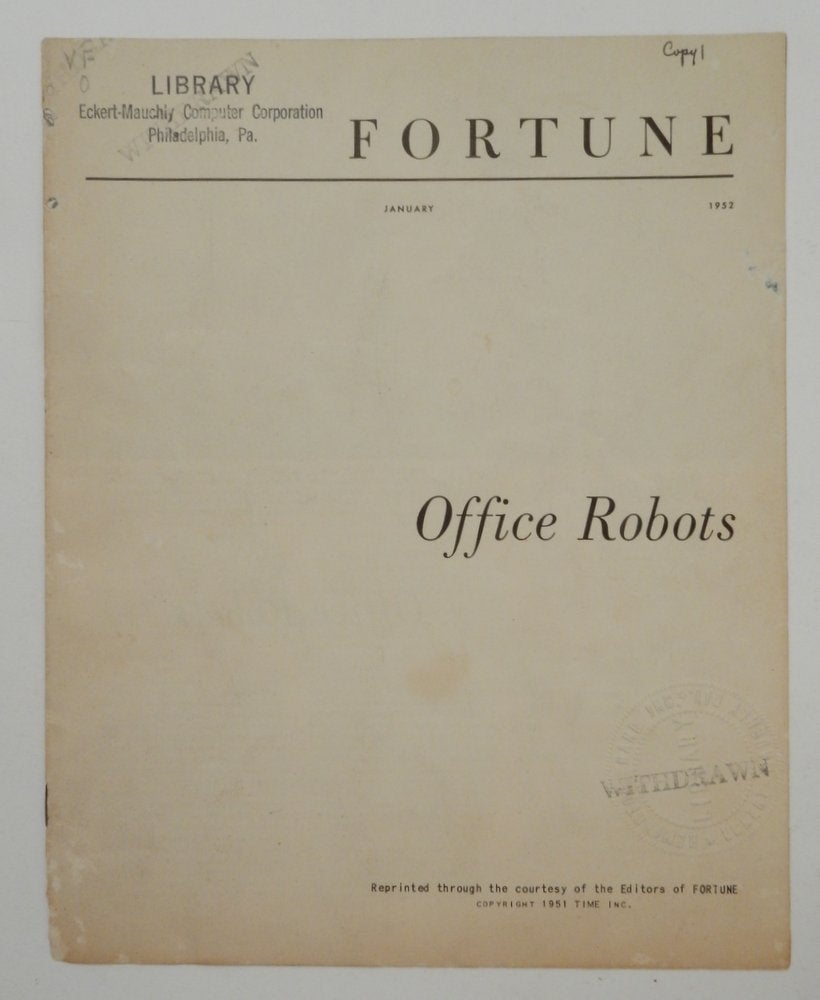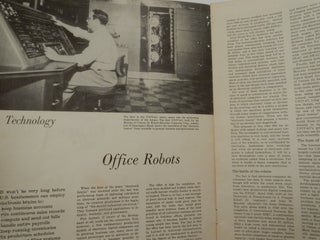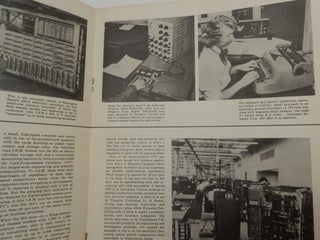Office Robots
[ no place ]: Time Inc. 1952. 9,[1-blank] pages plus wrappers. 8 x 10 inches. Marked "Copy 1" at top of front wrapper. Stamp upper left of "LIBRARY Eckert-Mauchly Computer Corporation Philadelphia, Pa." Embossed stamp of Remingtonj Rand Inc. Eckert-Mauchly Div. Library lower right. Both stamp and embossed stamp overstamped "WITHDRAWN". Soiling to rear panel, significant insect damage to extremities, mostly at base of spine panel. Good. Wraps. [27234]
A reprint of the article first published in FORTUNE, January 1952. The article provides an excellent overview of the state of the art, and deals with Rem Rand (Remington Rand) and I.B.M as two giants working as competitors to start turning out what today we call "big iron" - large scale machines that were used to tackle major business problems. It is an informative article not just because of the review of machines currently deployed but because it clearly identifies the differences between scientific applications (which need few inputs lots of number crunching and few outputs) and business applications (which require many inputs, number crunching and many outputs). Clearly stated are the then current bottlenecks - input and output processing devices - as well as the "hacks" that IBM and Rem Rand were using to try to shoehorn existing scientific machines into the office environment by adding peripheral devices to existing scientific main processing units. Since the first UNIVAC was delivered by Eckert and Mauchly to the US Census bureau on March 31, 1951, this is very early marketing exposure. It compares the work done by the UNIVAC on the census to the group of six IBM ESM systems doing 450 cards/minute.
Prescient is the discussion about the benefits and curses of automation still roiling today in public discourse (albeit now with "AI" being the latest buzzword). "There are two extreme views - both probably wrong - about what all this will mean to society. One holds that it will mean decimation of office staffs and technological unemployment on a scale heretofore unseen. The other holds that everything will work itself out fine, as in the past, without human intervention...Whether the advent of the electronic high-speed digital computer will mean an evolition or revolution is largeley a matter of definition. It will certainly engender, as it gathers momentum, one of the major changes in human society."
Martin Campbell-Kelly in "From Airlinne Reservations to Sonic the Hedgehog : A History of Software Industry", MIT Press:2003 notes the following about this Fortune article: "It was one of the very first general articles on computeres. No mention was made of programming or software - indeed, the latter term had not yet been invented." Martin goes on to note that the writer of the article likely had no understanding of programming or didn't think his readers needed to know given his use of "flipping a few switches" being sufficient to change the behavior of the machine.
A fascinating view into the past, prescient in some ways, and priced as an excellent association - material from Eckert-Mauchly's operation don't often appear on the market. Although we haven't seen any reprints of this article is was most likely used by Rem Rand salespeople over time as an early sales tool.
Not in Origins of Cyberspace or Tomash and Williams.
Provenance: The collection of Armand E Adams, manager for community relations for Sperry Rand Corp, Univac Division, Blue Bell PA. Adams was one of 25 people interviewed at the UNIVAC Conference in May 1990 (Charles Babbage Institute) who was "fundamentally involved with the development and use of the UNIVAC." (Yost, A Bibliographic Guide to Resources in Scientific Computing, 1945-1975).
ITEM SOLD




